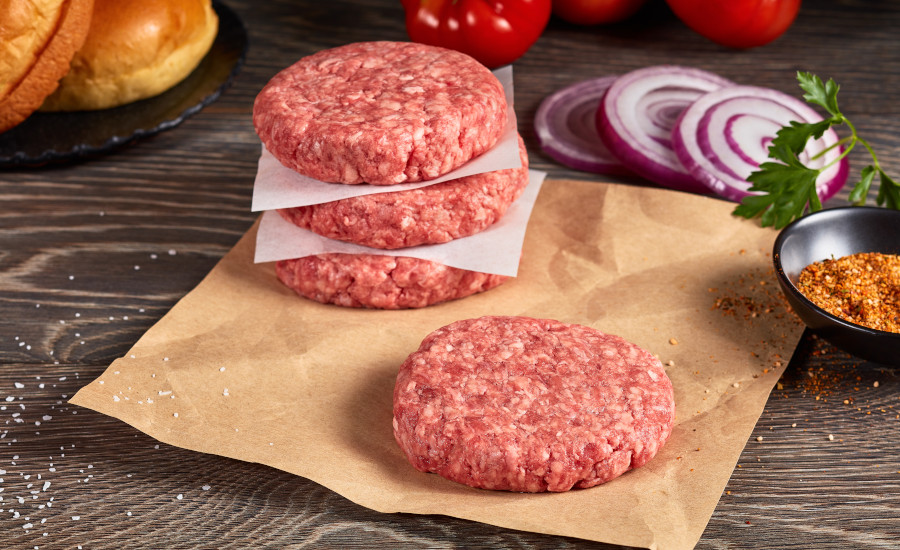One of the keys to the burger’s enduring popularity is the iconic American patty’s wide open possibilities for creativity.
At the Backdoor Grill in Steamboat Springs, Colo., the menu’s lineup of “Old School Burgers" is joined by its “New School Burgers.” The New School roster includes the How Ya Doin (with cream cheese, jalapeno jelly and bacon) and the Black Mamba 24 (with Snake River Farms Kobe beef, black truffle aioli, smoked sautéed onion, fried egg, and Gouda on a brioche bun).
“The last decade has seen the wild side of what is included in burgers -- and burger imitators -- with niche products including everything from peanut butter to mushrooms, but we are staying true to our roots and offering premium ground beef,” said Wes Wondercheck, vice president of sales for Greater Omaha Packing Co.
Despite the continual pushing of boundaries for what a burger can be, perhaps the largest trend is simply that burgers continue to be Americans’ go-to meal, said Jim Rogers, senior vice president for Creekstone Farms Premium Beef LLC. “Ground beef and burgers are a budget-friendly protein consumers know to be flavorful and versatile.”
Some chefs appreciate the appeal of a back-to-basics burger.
“I think the simplicity of a burger is what makes them so craveable,” said Josiah Citrin, a Los Angeles-based chef whose restaurant ventures includes Augie’s On Main, a fast-casual venue in Santa Monica. “At Augie’s, we grind our own meat to get the perfect amount of fat-to-meat ratio so that the flavor of the meat really shines.”
Purchasing trends
Almost half of consumers purchase ground beef once a week at retail, and two-thirds report eating ground beef at least once a week, according to research conducted by Midan Marketing. This could partially be influenced by pressure consumers are feeling from inflation.
“Burgers are an American staple – they are on more than 50% of menus nationwide, according to Datassentials’ The World of Burgers 2021 report,” said Elizabeth Rice, brand manager for BUBBA burger. “However, inflation concerns have many consumers eating out less. Many are recreating restaurant comfort foods at home.”
According to foodservice market research from Technomic, rising food costs combined with inflation-fueled consumer price-sensitivity are shrinking the value gap for quick-service and fast-casual restaurants. Fast casual’s value proposition for food quality is being challenged as consumers fail to notice a distinction between burgers sourced from these segments when ordered and consumed at home.
Family favorite
Busy families desire convenience and affordability, but also crave delicious burger flavor, Rice said. BUBBA burger’s line of frozen, ready-to-cook patties includes flavors ranging from Jalapeño Cheddar and Angus Beef to Bacon Cheddar and Turkey with Sweet Onion.
“Burgers are comfort food at its finest, and they are quick and convenient to prepare,” Rice said, adding that one of the biggest trends is a consumer preference for comfort foods.
Wondercheck said freshness, shelf life, color and eating experience are priorities for consumers that drive how Greater Omaha puts its ground beef blends together, using single-sourced, whole-muscle cuts.
“Burger options are as deep and wide as craft beers,” Wondercheck said. “Our approach is about crafting flavor profiles and menu appeal. The approach is just as much about what we don’t put in the burger as much as what we do. Sometimes less is more. Primal grinds are a simple way to upgrade and create separation from commodity grinds. We’re seeing increased demand for more artisanal options, like rib brisket chuck blends, as well as for classics like pure ground chuck, which offer a modest upgrade from commodity ground beef offerings marketed by lean point.”
In addition to its artisan butcher blends, Greater Omaha Packing provides different options of burger density and texture to meet customers’ needs. Wondercheck said Greater Omaha Packing’s homestyle patty works well for open flame grills, while their puck option performs a little better on flat-top stoves and in skillets.

With meat case pricing continuing its upward trend, many shoppers will prioritize value over variety when weighing their burger purchase decision.
“We are not looking to make designer burgers that are only occasional indulgences,” Wondercheck said. “Instead, we want to help our customers keep beef at the center of the plate.”
When consumers purchase beef, they are seeking the right balance between value and quality, he said. Many consumers are stretching their food dollars due to inflation, yet they still desire a great eating experience.
“For retailers, we’ve found a growing niche in the offering of fresh convenience burgers,” Wondercheck said. “We are experiencing growing demand for our retail-ready, fresh, vacuum-sealed burgers. The packages are leak-proof so they can easily be taken for weekend at the lake, and the burgers are grill-ready without any additional handling. Our fresh, gourmet Hereford Chuck burgers, for example, are a win-win for busy families balancing price, quality, and convenience. Pre-shaped into 7-ounce homestyle burgers, our 1.75-pound pouches can feed a small family for under $8”.
Adding value through labor savings
With staffing shortages a continuing challenge for foodservice operators, pre-portioned burgers can provide a ready-for-the-grill solution requiring limited preparation.
“For retailers and foodservice operators, we help them save the time and added expense of grinding their own burgers in-house by providing chubs, which can strengthen their bottom line and provide strong food safety and product quality,” Rogers said. “Convenience for our retail and foodservice partners is about getting a premium product just how they need it, so we offer chubs, bricks, pucks, and patties. Whether we are servicing foodservice or retail, making sure packaging and portioning options meet the needs of our customers is table stakes for us, and one of the keys to our continued success.
Motivating messaging
Many consumers want to know more about how their ground beef was produced, and research suggests seeing a production claim can influence consumers to purchase a product.
“Claims like no antibiotics ever, no added hormones and natural are indicators of quality to many consumers,” Rogers said. “We have seen huge popularity in our Natural Black Angus Beef for retail and foodservice customers, as well as in the direct-to-consumer space.”
He said Creekstone’s Natural Black Angus beef products can be traced to the ranch of origin and offer claims like “no antibiotics ever” and “no added hormones.”
.png?height=96&t=1647275041&width=96)



Report Abusive Comment